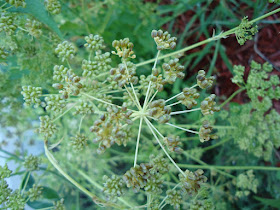After reading
EG's post about composting this morning, I felt deflated, like we were a textbook case of how NOT to compost. Is our beginner's composting effort totally doomed? Please read on and let us know your thoughts.
Since Keith and I decided to start our own vegetable garden, my feelings regarding home composting have evolved from common fear (is our backyard going to stink like a mini landfill?), to cautious intrigue (can we really turn everyday garbage into "black gold"?), and finally to newbie enthusiasm (let's do it!).
I did some online research on how to start backyard composting at home, and learned about "browns" and "greens," also known as carbon and nitrogen sources. I also read up on oxygen and water requirements for good composting. We looked at countless pictures of backyard compost bins, checked out a few commercial composters at local garden stores, and eventually made a decision to build our own.
The "building" part was actually really easy. We bought a food grade 55-gallon plastic barrel with a screw top lid from someone on craigslist for $20. We then drilled many holes at regular intervals all around the barrel (including top and bottom) for air circulation and drainage.
Next up was the "filling" part. I didn't really think through this part very well. I had a vague idea that we would just toss all our kitchen scraps (minus the meats and the fats) in there, mix in some grass clippings and leaves, and we would magically have our compost some months later. Ha, it didn't actually work out like that.
First problem: 55 gallons is actually a really big space to fill with kitchen scraps from a household of two adults. Grass clippings added some bulk, but we discovered that they reduce down a lot as they start decomposing.
Second problem: we live in a new-ish subdivision, and we only have one very small tree on our property. So... no brown leaves for the compost pile. I told Keith that come fall time, we might have to sneak around the neighborhood at nights with a large trash bag and collect brown leaves from our more established neighbors. He didn't like that idea so much.
Anyway, our current composting routine goes something like this:
- We keep a small plastic container (big enough to fit a plastic grocery bag inside) in the kitchen for all vegetable and fruit scraps. I'm anal enough to chop everything into smaller pieces, because I read that small pieces are more accessible for microorganisms during the composting process. Keith thinks it's funny that I chop things like watermelon rind into bite sized pieces, only to throw them away in the compost. Hey, if it's worth doing, it's worth doing well.
- We toss in crushed eggshells and used coffee grounds whenever we have them.
- When the small container gets full, it gets emptied into the compost barrel sitting in the backyard.
- We add some newspaper (hand-shredded into approximately 1/2 inch wide strips) in the compost barrel as our main carbon source.
- Grass clippings get added to the compost barrel after mowing.
- Oh, our compost barrel also serves as an earthly gateway to vegetable plant heaven.
- We spray water inside the compost barrel daily to make sure that it stays sufficient moist (but not too wet) inside.
- The compost barrel gets rolled around on a weekly basis to ensure proper aeration.
We don't keep track of the volume ratio between browns (newspaper) and greens (kitchen scraps, grass clippings and dead vegetable plants), but we haven't had any issues with bad smells, which I read may be attributed to the way-off brown/green ratio, so I'm crossing my fingers and hoping that our ratio is at least somewhat acceptable.
So far, things look okay in the compost barrel. Everything is starting to decompose into a dark brown mass without smelling bad. We don't have a compost thermometer, so we don't know if our compost is heating up to the ideal range of 130F - 150F. The barrel is still only about a third full, and we keep adding more browns and greens to it, so I guess we can't expect to get any usable compost out of it until at least several months after we get the whole thing full. I'm starting to realize the limitations of the one bin (or barrel, in our case) composting method.
I also found this fascinating tidbit on
wiki:
People excrete far more plant nutrients (nitrogen, phosphorus, potassium) in urine than in feces. Human urine can be used directly as fertilizer or it can be put onto compost. Adding a healthy person's urine to compost usually will increase temperatures and therefore increase its ability to destroy pathogens and unwanted seeds.
I asked Keith if he would consider peeing in our compost barrel. He countered with an offer to add a built-in toilet seat to the compost barrel lid, complete with a step stool for me to climb up to the top. I think he was kidding. At least I hope he was. I may be eager, but I guess I'm not THAT dedicated to composting. Yet.
Aside from building a new compost pile (the barrel did not work well for EG) and finding a good source of browns for carbon (EG mentioned that paper is not a good choice of browns), do you have any ideas on how we can salvage our composting method? Does spraying your compost pile with tap water really kill all the good microbes? It's not so much that I want to doubt EG, I'm just so sad thinking about how we may have been killing all our compost microbes with our daily watering.




















































